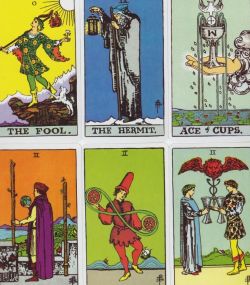 Are one of the most widely used and known psychic tools, and have been used for centuries. Most Tarot Card Readers focus on the major 22 arcana cards during Tarot Readings. These arcane cards emphasize the major aspects of life and our psychic readers use the cards to enhance their ability, in order to provide answers to specific questions or to indicate a change that may be coming.
Are one of the most widely used and known psychic tools, and have been used for centuries. Most Tarot Card Readers focus on the major 22 arcana cards during Tarot Readings. These arcane cards emphasize the major aspects of life and our psychic readers use the cards to enhance their ability, in order to provide answers to specific questions or to indicate a change that may be coming.
Tarot reading revolves around the belief that the cards can be used to gain insight into the current and possible future situations of the subject (or querent), i.e. cartomancy. Some believe they are guided by a spiritual force, such as Gaia, while others believe the cards help them tap into a collective unconscious or their own creative, brainstorming subconscious. The divinatory meanings of the cards are derived mostly from the Kabbalah of Jewish mysticism and from Medieval Alchemy.
Tarot cards were not widely adopted by mystics, occultists and secret societies until the 18th and 19th centuries. The tradition began in 1781, when Antoine Court de Gébelin, a Swiss clergyman and Freemason, published Le Monde Primitif, a speculative study which included religious symbolism and its survivals in the modern world. De Gébelin first asserted that symbolism of the Tarot de Marseille represented the mysteries of Isis and Thoth. Gébelin further claimed that the name "tarot" came from the Egyptian words tar, meaning "royal", and ro, meaning "road", and that the Tarot therefore represented a "royal road" to wisdom. De Gébelin also asserted that the Gypsies, who were among the first to use cards for divination, were descendants of the Ancient Egyptians (hence their common name; though by this time it was more popularly used as a stereotype for any nomadic tribe) and had introduced the cards to Europe. De Gébelin wrote this treatise before Jean-François Champollion had deci